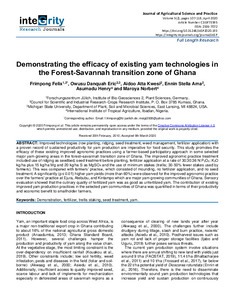| dc.contributor.author | Frimpong, F. |
| dc.contributor.author | Owusu, D.E., |
| dc.contributor.author | Aidoo, A.K. |
| dc.contributor.author | Ennin, S.A. |
| dc.contributor.author | Asumadu, H. |
| dc.contributor.author | Maroya, N. |
| dc.date.accessioned | 2022-04-21T14:03:03Z |
| dc.date.available | 2022-04-21T14:03:03Z |
| dc.date.issued | 2020-04 |
| dc.identifier.citation | Frimpong, F., Owusu D.E., Aidoo, A.K., Ennin, S.A., Asumadu, H. & Maroya, N. (2020). Demonstrating the efficacy of existing yam technologies in the forest-savannah transition zone of Ghana. Journal of Agricultural Science and Practice, 5(2), 107-118. |
| dc.identifier.issn | 2536-7072 |
| dc.identifier.uri | https://hdl.handle.net/20.500.12478/7427 |
| dc.description.abstract | Improved technologies (row planting, ridging, seed treatment, weed management, fertilizer application) with a proven record of sustained productivity for yam production are imperative for food security. This study promotes the efficacy of these existing improved agronomic practices using a farmer-based participatory approach in some selected major yam-growing areas in the forest–savannah transition zone of Ghana. The improved agronomic practice treatment included use of ridging as seedbed, seed treatment before planting, fertilizer application at a rate of 30:30:36 N:P2O5: K2O kg/ha plus 15 kg/ha Mg and 20 kg/ha S as MgSO4 and the use of minimum stakes (trellis; 30-50% fewer stakes used by farmers). This was compared with farmers’ practice, which consisted of mounding, no fertilizer application, and no seed treatment. A significantly (p ≤ 0.01) higher yam yields (more than 60%) were observed for the improved agronomic practice over the farmers’ practice at Ejura, Atebubu, and Kintampo which are major yam-growing communities of Ghana. Sensory evaluation showed that the culinary quality of fertilized yam was as good as unfertilized yam. The contribution of existing improved yam production practices in the selected yam communities of Ghana was quantified in terms of their productivity and economic benefit to smallholder farmers. |
| dc.description.sponsorship | Bill & Melinda Gates Foundation |
| dc.format.extent | 107-118 |
| dc.language.iso | en |
| dc.subject | Pilot Farms |
| dc.subject | Fertilizers |
| dc.subject | Staking |
| dc.subject | Seed Treatment |
| dc.subject | Yams |
| dc.subject | Ghana |
| dc.title | Demonstrating the efficacy of existing yam technologies in the forest-savannah transition zone of Ghana |
| dc.type | Journal Article |
| cg.contributor.crp | Roots, Tubers and Bananas |
| cg.contributor.affiliation | Forschungszentrum Jülich, Institute of Bio-Geosciences 2, Germany |
| cg.contributor.affiliation | Council for Scientific and Industrial Research-Crops Research Institute, Ghana |
| cg.contributor.affiliation | Michigan State University |
| cg.contributor.affiliation | International Institute of Tropical Agriculture |
| cg.coverage.region | Africa |
| cg.coverage.region | West Africa |
| cg.coverage.country | Ghana |
| cg.coverage.hub | Headquarters and Western Africa Hub |
| cg.researchtheme | Biotech and Plant Breeding |
| cg.identifier.bibtexciteid | FRIMPONG:2020 |
| cg.isijournal | ISI Journal |
| cg.authorship.types | CGIAR and developing country institute |
| cg.iitasubject | Agronomy |
| cg.iitasubject | Food Security |
| cg.iitasubject | Plant Breeding |
| cg.iitasubject | Plant Production |
| cg.iitasubject | Yam |
| cg.journal | Journal of Agricultural Science and Practice |
| cg.notes | Open Access Article |
| cg.accessibilitystatus | Open Access |
| cg.reviewstatus | Peer Review |
| cg.usagerightslicense | Creative Commons Attribution 4.0 (CC BY 0.0) |
| cg.targetaudience | Scientists |
| cg.identifier.doi | https://dx.doi.org/10.31248/jasp2020.193 |
| cg.iitaauthor.identifier | Norbert Maroya: 0000-0002-7079-4729 |
| cg.futureupdate.required | No |
| cg.identifier.issue | 2 |
| cg.identifier.volume | 5 |

